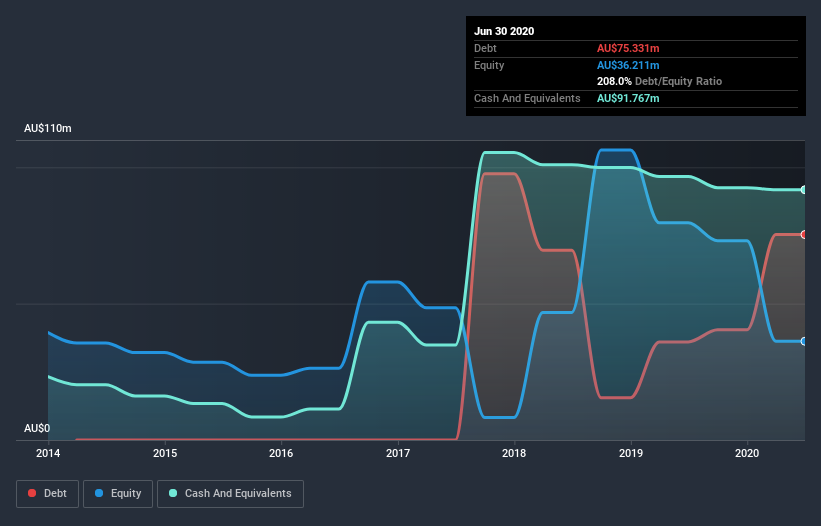Berkeley Energia (ASX:BKY) May Not Be Profitable But It Seems To Be Managing Its Debt Just Fine, Anyway

Howard Marks put it nicely when he said that, rather than worrying about share price volatility, 'The possibility of permanent loss is the risk I worry about... and every practical investor I know worries about.' So it seems the smart money knows that debt - which is usually involved in bankruptcies - is a very important factor, when you assess how risky a company is. Importantly, Berkeley Energia Limited (ASX:BKY) does carry debt. But the more important question is: how much risk is that debt creating?
When Is Debt Dangerous?
Debt and other liabilities become risky for a business when it cannot easily fulfill those obligations, either with free cash flow or by raising capital at an attractive price. In the worst case scenario, a company can go bankrupt if it cannot pay its creditors. However, a more common (but still painful) scenario is that it has to raise new equity capital at a low price, thus permanently diluting shareholders. Of course, the upside of debt is that it often represents cheap capital, especially when it replaces dilution in a company with the ability to reinvest at high rates of return. The first thing to do when considering how much debt a business uses is to look at its cash and debt together.
Check out our latest analysis for Berkeley Energia
How Much Debt Does Berkeley Energia Carry?
As you can see below, at the end of June 2020, Berkeley Energia had AU$75.3m of debt, up from AU$36.0m a year ago. Click the image for more detail. But it also has AU$91.8m in cash to offset that, meaning it has AU$16.4m net cash.
A Look At Berkeley Energia's Liabilities
Zooming in on the latest balance sheet data, we can see that Berkeley Energia had liabilities of AU$78.8m due within 12 months and no liabilities due beyond that. Offsetting these obligations, it had cash of AU$91.8m as well as receivables valued at AU$1.44m due within 12 months. So it actually has AU$14.4m more liquid assets than total liabilities.
This short term liquidity is a sign that Berkeley Energia could probably pay off its debt with ease, as its balance sheet is far from stretched. Succinctly put, Berkeley Energia boasts net cash, so it's fair to say it does not have a heavy debt load! The balance sheet is clearly the area to focus on when you are analysing debt. But it is Berkeley Energia's earnings that will influence how the balance sheet holds up in the future. So if you're keen to discover more about its earnings, it might be worth checking out this graph of its long term earnings trend.
While it hasn't made a profit, at least Berkeley Energia booked its first revenue as a publicly listed company, in the last twelve months.
So How Risky Is Berkeley Energia?
By their very nature companies that are losing money are more risky than those with a long history of profitability. And we do note that Berkeley Energia had an earnings before interest and tax (EBIT) loss, over the last year. And over the same period it saw negative free cash outflow of AU$7.4m and booked a AU$43m accounting loss. Given it only has net cash of AU$16.4m, the company may need to raise more capital if it doesn't reach break-even soon. Importantly, Berkeley Energia's revenue growth is hot to trot. While unprofitable companies can be risky, they can also grow hard and fast in those pre-profit years. The balance sheet is clearly the area to focus on when you are analysing debt. However, not all investment risk resides within the balance sheet - far from it. For instance, we've identified 2 warning signs for Berkeley Energia that you should be aware of.
At the end of the day, it's often better to focus on companies that are free from net debt. You can access our special list of such companies (all with a track record of profit growth). It's free.
This article by Simply Wall St is general in nature. It does not constitute a recommendation to buy or sell any stock, and does not take account of your objectives, or your financial situation. We aim to bring you long-term focused analysis driven by fundamental data. Note that our analysis may not factor in the latest price-sensitive company announcements or qualitative material. Simply Wall St has no position in any stocks mentioned.
Have feedback on this article? Concerned about the content? Get in touch with us directly. Alternatively, email editorial-team@simplywallst.com.

 Yahoo Finance
Yahoo Finance 
